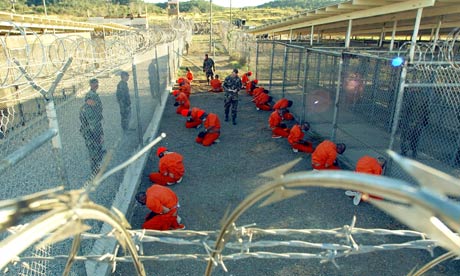Guantanamo Bay Detention Center – An American Humiliation

“As President, I will close Guantanamo….” President Obama repeated this promise many times during his 2008 campaign, making it a central issue in the election. In the beginning of his first term he did indeed take several steps, which made it appear that a closure was looming in the near future. In fact, on his first full day in office in 2009, the President issued an executive order mandating that the prison be closed within one year and its prisoners transferred. Later that year, however, the Senate did not approve the necessary funding to execute this initiative. After these initial developments and subsequent setbacks, it seems that the public interest in Guantanamo Bay has waned, but what is the current status of the nation’s most notorious prison?
It is well known that though the first prisoners arrived at the Guantanamo Bay Detention Center (Gitmo for short) at the US Naval Base on Cuba January 11, 2002, the White House did not acknowledge the application of the Geneva Convention, which regulates humane treatment of prisoners, until 2009. During these early years, Guantanamo was used for the detention and torture of suspected terrorists as well as individuals with information pertinent to the U.S.’s War on Terror. As Susan J Crawford, the Convening Authority for the Guantanamo Military Commissions, explained in regards to Mohammed al-Qahtani, accused of attempting to participate in the 9/11 hijacking,
“…the techniques they used [to interrogate Qahtani] were all authorized, but the manner in which they applied them was overly aggressive and too persistent…you think of torture, you think of some horrendous physical act done to an individual. This was not any one particular act; this was just a combination of things that had a medical impact on him, that hurt his health, it was abusive and uncalled for. And coercive. Clearly coercive.”
The reality of Guantanamo since 2009 is certainly very different than during the Bush administration. It is accepted that methods of advanced interrogation, or torture, have not been used under President Obama. Despite this success, Obama has made very little progress in actually fulfilling his promise to close Guantanamo. In fact, it is highly unlikely to be closed anytime in the near future. Despite the President’s confident claims, he has been unsuccessful in gaining support for closure in the Senate. In fact, in January 2013, Obama signed the National Defense Authorization Act of 2013 (NDAA) that stipulates that the executive branch cannot transfer detainees to a different country. In other words, just within the last month Obama signed away his ability to transfer the current detainees out of Guantanamo and shut it down.
The strong governmental resistance to the closure of Guantanamo convinces many citizens of its importance in defending the United States. In truth, however, this prison is doing much more harm than good. With evidence of former interrogation techniques such as strip searches, use of chains and leashes, and 18-20 hour interrogations, it is clear that Guantanamo Bay has become, in the words of Admiral Blair, Obama’s former head of National Intelligence, “ a damaging symbol to the world.” This perception was only furthered by the release of the Guantanamo files after they were provided to Wikileaks by soldier Bradley Manning. These files provide disturbing details on the detainees of Guantanamo. For example, it was revealed that a fourteen-year-old kidnapping victim was held and tortured for information on Al Qaeda leaders. Though many individuals may argue that these horrors are in the past, and though torture may no longer be common practice at Guantanamo, the air of secrecy surrounding this prison as well as its damaging reputation more than substantiate the argument that it is in the best interest of the United States to close Guantanamo immediately.
Currently, trials for Guantanamo Bay detainees, specifically the 9/11 masterminds, are underway. These trials have raised many questions about the secrecy surrounding Guantanamo. For example, the defense team has requested to spend 48 hours in Camp 7, referred to as Guantanamo’s “crown jewel of secrecy” to observe some version of their clients’ day-to-day reality. Tellingly, the Prosecution is fighting back against this request, offering instead a two hour guided tour of the prison. This type of continuing secrecy, coupled with earlier revelations of censoring, simply reinforce the problems with Guantanamo. Regardless of the positive changes the detainee program has undergone, this prison holds too many secrets, corruptions to remain open.
Ultimately, the necessary resolution is clear—the United States must reach a bipartisan agreement to shut down the Guantanamo Bay Detention Center. It serves as an embarrassment to this country and what we stand for while providing very few real services to our national safety, especially as information obtained under duress is often unreliable. Of course some of the prisoners detained at Guantanamo constitute legitimate threats to the United States, and it is imperative that these individuals face swift and severe repercussions. However, these repercussions must be dealt through legitimate legal channels both for efficacy, morality, and the reputation of the United States.